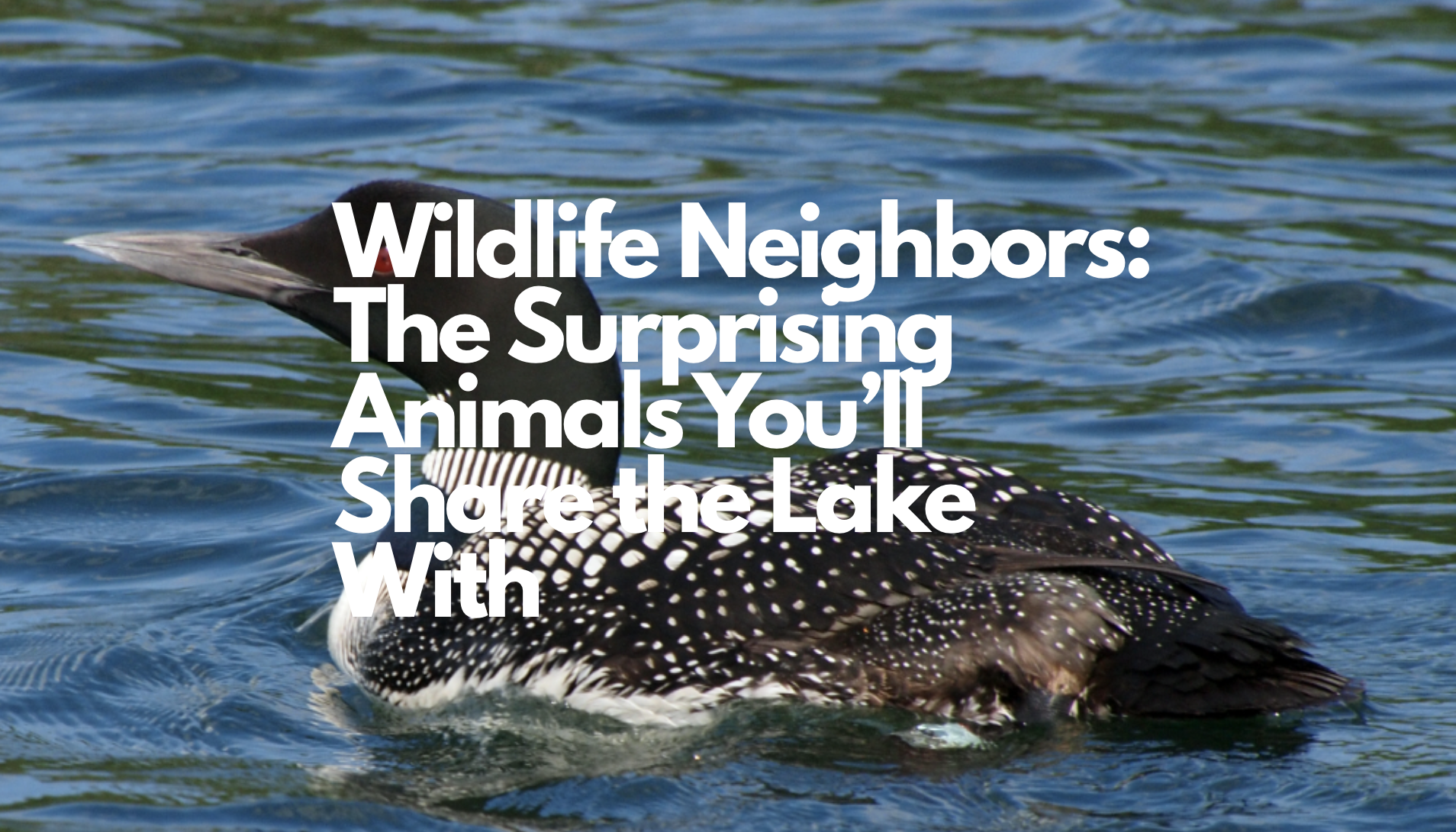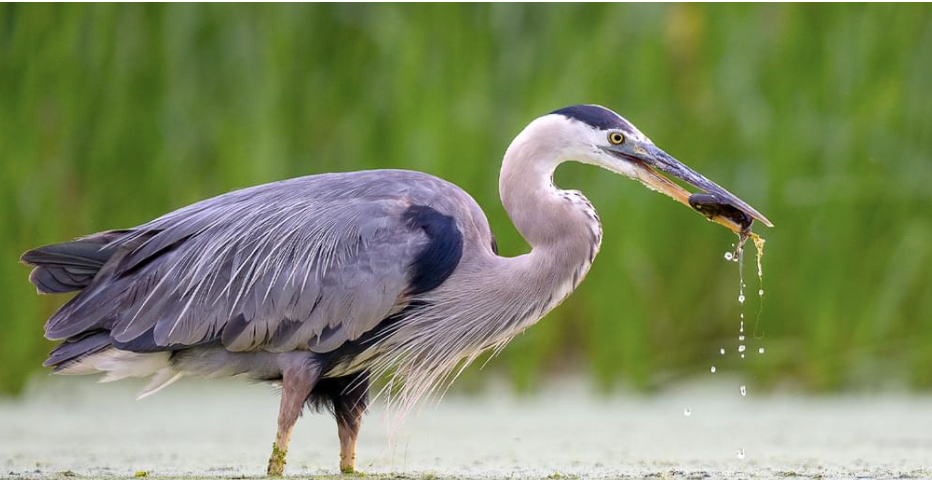
When most people picture their dream lakefront home, they imagine shimmering waters, the sound of waves lapping at the shore, and maybe a boat tied neatly to the dock. What they may not realize is that a lakefront property also comes with a built-in community of neighbors…feathered, furry, and sometimes even a little slimy. The lake wildlife you encounter is as much a part of the lakefront lifestyle as fishing, boating, or swimming.
Understanding these creatures does not just add wonder to your lake experience, it also helps you become a good steward of the environment that makes lake living so magical. Let’s take a look at some of the surprising animals you may share your lakefront property with.
The Birds That Define Lake Life
Loons
- If you have ever spent a quiet evening on a northern lake, you have likely heard the haunting call of the common loon. Their eerie, beautiful song has become a symbol of wilderness lakes across North America. Loons are expert divers and can swim up to 200 feet below the surface chasing fish. While they are mesmerizing to watch, they are also very sensitive to human activity. Too much boat traffic near their nests can cause them to abandon eggs. For lakefront homeowners, maintaining a respectful distance during nesting season is part of protecting these iconic birds.
Great Blue Herons
- Tall, graceful, and prehistoric looking, herons are often spotted silently stalking fish along the shoreline. They have adapted well to living near humans, but they still prefer quiet areas with minimal disruption. A heron landing on your dock can be a breathtaking sight and a reminder that your property is part of a larger ecosystem.
Bald Eagles and Ospreys
- For many lake homeowners, seeing an eagle swoop down to snatch a fish from the water is a bucket-list moment. These birds of prey have made a remarkable comeback in recent decades, and many lakes now have nesting pairs. Ospreys, sometimes called “fish hawks,” are smaller but just as impressive when diving into the water talons first. Installing a simple osprey nesting platform on your property can even encourage them to call your shoreline home.

Mammals: From Playful Otters to Curious Visitors
River Otters
- Perhaps the most entertaining lake neighbors you will ever meet, otters are playful, social animals that often travel in family groups. Watching them slide down muddy banks, chase each other in the water, or pop their heads up like curious onlookers can bring endless joy. Though often mistaken for muskrats, otters are larger, sleeker, and more acrobatic.
Beavers
- Beavers are master builders and can dramatically shape a shoreline with their lodges and dams. While some homeowners worry about damage to trees, beavers also create rich wetland habitats that support countless other species. If you find gnawed stumps or chewed logs near your shoreline, you may have a busy beaver nearby.

Deer and Other Land Mammals
It is not unusual to see deer cautiously making their way down to the shoreline for a drink, especially in the early morning or at dusk. Depending on your region, you might also see raccoons, foxes, or even the occasional black bear using the lake as a resource. Remember, these animals are drawn by water and food sources, so secure garbage cans and avoid leaving pet food outdoors.
Amphibians and Reptiles: The Quiet Contributors
Frogs and Toads
- The evening chorus of frogs is one of the most underrated joys of lakefront living. These amphibians are excellent indicators of water quality since they absorb toxins through their skin. If frogs thrive on your lake, it is a good sign that the ecosystem is healthy. Children especially love spotting tadpoles in shallow water, proof of a natural cycle at work.
Turtles
- Painted turtles and snapping turtles are common sights in many lakes. You might see them sunning on a log or gliding gracefully just below the surface. Turtles are long lived creatures, with some living 40 years or more. If you are lucky, you may witness a turtle laying eggs in sandy soil near your property, a reminder of the importance of leaving natural areas undisturbed.
Snakes
- Not everyone is thrilled to encounter snakes, but most freshwater snakes are harmless and actually beneficial. They control rodent and insect populations and rarely pose a threat to humans if left alone. In some regions, water snakes may be mistaken for venomous species, but education goes a long way in easing fears.

Fish: More Than Just a Catch
Of course, no list of lakefront wildlife would be complete without fish. Whether you are an avid angler or simply enjoy watching them from the dock, fish are central to the ecosystem. Bass, perch, trout, and sunfish are just a few of the species that bring life to the water. Stocking programs and conservation efforts often help maintain healthy populations.
What many people overlook is how fish activity influences other wildlife. Loons, ospreys, and eagles rely on abundant fish to survive. Even mammals like otters and raccoons depend on fish as a major food source. By respecting fishing regulations and supporting conservation, homeowners play a direct role in sustaining the balance of lake life.
Insects: The Buzzing Reality of Lakefront Living
It is true that living on the water means sharing space with insects. But not all are nuisances.
- Dragonflies: With their iridescent wings and aerial acrobatics, dragonflies are mosquito-eating machines and a delight to watch.
- Bees and Butterflies: Planting wildflowers and native plants along your shoreline can attract pollinators that benefit the entire ecosystem.
- Mosquitoes: Yes, they are part of the deal. But maintaining natural shoreline vegetation and using environmentally safe repellents can help keep their numbers down.

Becoming a Good Neighbor Yourself
Just as you expect courtesy from your human neighbors, wildlife requires the same respect. Here are a few ways to live in harmony with the animals of your lake:
- Maintain Natural Shoreline Buffers: Native plants not only prevent erosion but also provide critical habitat.
- Use Eco-Friendly Products: Avoid fertilizers, pesticides, and harsh chemicals that run off into the lake.
- Respect Nesting and Breeding Seasons: Whether it is a loon nesting on a small island or a turtle burying eggs in your yard, giving wildlife space ensures future generations thrive.
- Secure Human Food Sources: Do not unintentionally invite raccoons or bears by leaving out garbage or pet food.
- Educate Guests and Kids: The more everyone knows about the animals they encounter, the more they will appreciate and protect them.
The Magic of Coexistence
Owning a lakefront home is not just about the water views or recreation, it is about becoming part of a living, breathing ecosystem. The loons that serenade you at night, the heron that stalks silently in the shallows, the otters that put on a show near your dock, these are the neighbors that make lake life extraordinary.
By appreciating and protecting the wildlife that shares your shoreline, you ensure that future generations will experience the same magic. After all, it is not just your lakefront property, it is their home too.
Posted by Scott Freerksen “The Lake Guy”
